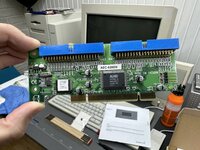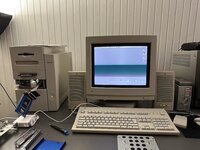Phipli
Well-known member
Sigh. Going to need to drag out a Beige G3. Which means unsetting up the Centris 650 or the B&W.Rev C ROM.
Another time perhaps. Both have ongoing projects.
Sigh. Going to need to drag out a Beige G3. Which means unsetting up the Centris 650 or the B&W.Rev C ROM.
This is why I said I don’t think the 8GB restriction applies to classic Mac OS, just OS X.
This makes sense to me.So I theorize that the limitation is due to the OpenFirmware IDE support which BootX, the OSX booter, uses. Whereas OS9 uses IDE support in the ToolBox ROM and doesn't use OFW.
The original iMac was an odd one. If I'm not mistaken, it was a sort of transitional machine that was predominantly New World, but with notable Old World vestiges still extant (internal use of legacy ports (for example, DA-15 for connecting the internal CRT to the LB and serial for the IrDA sensor on early iMacs (Rev. A for sure, and maybe also Rev. B?), the presence of an unimplemented but more or less functional internal floppy support). I'm sure some of the Old World OpenFirmware quirks were carried over too.What I find interesting is that the original iMac (Rev A only?) has the OF limitation too. It’s not strictly an Old World thing.
The iMac is 100% New world, in that what this means is that they stopped using the traditional large logic board based ROM.The original iMac was an odd one. If I'm not mistaken, it was a sort of transitional machine that was predominantly New World, but with notable Old World vestiges still extant (internal use of legacy ports (for example, DA-15 for connecting the internal CRT to the LB and serial for the IrDA sensor on early iMacs (Rev. A for sure, and maybe also Rev. B?), the presence of an unimplemented but more or less functional internal floppy support). I'm sure some of the Old World OpenFirmware quirks were carried over too.
c
Not this, it happened at the same time, but New World just refers to the ROM change.that and the inclusion of onboard USB
I think it made sense to make this transition with Mac OS X on the horizon, which would no longer need the Toolbox. So they could save costs by using a smaller chip, and add flexibility by making it flashable.Not this, it happened at the same time, but New World just refers to the ROM change.
This is present for at least the rev C as well.DA-15 for connecting the internal CRT to the LB
I just ordered the PCI IDE/ATA card with a 2.5-inch SSD drive and a 3.5-inch adapter. It set me back 200 USD
the AEC-6280M, which cost me roughly 24 USD
Well, the extra SSD drive was 170 USD, but it seems as if I don’t need it now when Mercury is working.How did you go down from 200 to 24 dollars? Haha.
That seems really expensive. Last I checked, a 1TB Crucial MX500 was around £70 over here in the UK.Well, the extra SSD drive was 170 USD, but it seems as if I don’t need it now when Mercury is working.
Yes, really expensive! The drive I ordered was an new old stock 2.5 Transcend 64 GB IDE/ATA SSD. I went with it because I use one in my Pismo and it feels reliable.That seems really expensive. Last I checked, a 1TB Crucial MX500 was around £70 over here in the UK.



That's normal. SATA cards are too. They interface to the SCSI hooks in open firmware to be bootable. I forget why, probably faster or something.The only weird thing I can think of is that the Acard ATA-133 is recognised as “SCSI-buss 1” -- and I haven't found anything in the manual that explains why.
Well, as long as it’s faster I’m okey!That's normal. SATA cards are too. They interface to the SCSI hooks in open firmware to be bootable. I forget why, probably faster or something.
Here’s an update on the Mercury Electra SSD in a Beige G3 MT.
The Acard ATA-133 AEC-6280M arrived an hour ago with cabling. Instalment was instant, and the system recognised the card right away. I booted from a 9.2.1 CD, opened Drive Setup, found Mercury Electra SSD (120 GB), made two partitions and installed MacOS 9.2.1. So far, everything works nicely. After benching the drive against the stock configuration, I can gladly say it’s almost five times faster.
If I had known, I would only have bought the AEC-6280M, which cost me roughly 24 USD. I’ll do some more tests and post some pictures later this weekend. Thanks for all the help so far!
I use this one from amazon, I've found it works in nearly any situation as it has so many different mounting holes in it. https://www.amazon.com/dp/B00G57BN1M?ref=ppx_yo2ov_dt_b_product_details&th=1Btw. If someone knows a good source for a 3.5-inch mounting bracket adapter, I’d love to know!
